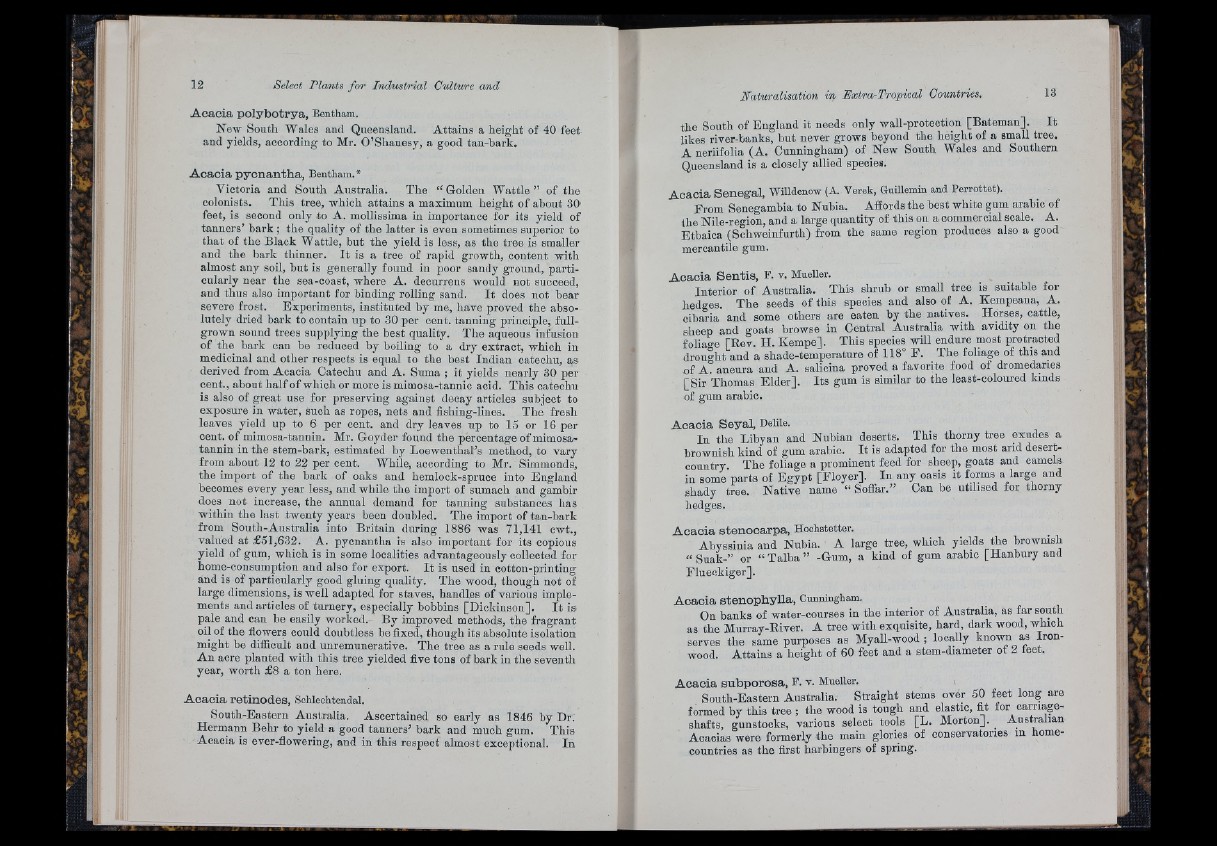
A c a c ia p o ly b o try a , Bentham.
New South Wales and Queensland. Attains a height of 40 feet
and yields, according to Mr. O’Shanesy, a good tan-bark.
A c a c ia p y c n a n th a , Bentham.*
Victoria and South Australia. The “ Golden W a ttle ” of the
colonists. This tree, which attains a maximum height of about 30-
feet, is second only to A. mollissima in importance for its yield of
tanners’ bark ; the quality of the latter is even sometimes superior to
th a t of the Black Wattle, but the yield is less, as the tree is smaller
and the bark thinner. I t is a tree of rapid growth, content with
almost any soil, but is generally found in poor sandy ground, p articularly
near the sea-coast, where A. decurrens would not succeed,
and thus also important for binding rolling sand. I t does not bear
severe frost. Experiments, instituted by me, have proved the absolutely
dried bark to contain up to 30 per cent, tanning principle, full-
grown sound trees supplying the best quality. The aqueous infusion
of the bark can be reduced by boiling to a dry extract, which in
medicinal and other respects is equal to the best Indian catechu, as
derived from Acacia Catechu and A. Suma ; it yields nearly 30 per
cent., about h a lf of which or more is mimosa-tannic acid. This catechu
is also of great use for preserving against decay articles subject to
exposure in water, such as ropes, nets and fishing-lines. The fresh
leaves yield up to 6 per cent, and dry leaves up to 15 or 16 per
cent, of mimosa-tannin. Mr. Goyder found the percentage of mimosa-
tannin in the stem-bark, estimated by Loeweuthal’s method, to vary
from about 12 to 22 per cent. While, according to Mr. Simmonds,
the import of the bark of oaks and hemlock-spruce into England
beoomes every year less, and while the import of sumach and gambir
does not increase, the annual demand for tanning substances has
within the last twenty years been doubled. The import of tan-bark
from South-Australia into Britain during 1886 was 71,141 cwt.,
valued at £51,632. A. pycnantha is also important for its copious
yield of gum, which is in some localities advantageously collected for
home-consumption and also for export. I t is used in cotton-printing
and is of particularly good gluing quality. The wood, though not of
large dimensions, is well adapted for staves, handles of various implements
and articles of turnery, especially bobbins [Dickinson]. I t is
pale and can be easily worked. By improved methods, the fragrant
oil of the flowers could doubtless be fixed, though its absolute isolation
might be diffleult and unremunerative. The tree as a rule seeds well.
An acre planted with this tree yielded five tons of bark in the seventh
year, worth £8 a ton here.
A c a c ia re tin o d e s , Schlechtendal.
South-Eastern Australia. Ascertained so early as 1846 by Dr.
Hermann Behr to yield a good tanners’ bark and much gum. This
Acacia is ever-flowering, and in this respect almost exceptional. In
the South of England it needs only wall-proteotion [Bateman]. I t
likes rlver-banks, but never grows beyond the height of a small tree.
A neriifolia (A. Cunningham) of New South Wales and Southern
Queensland is a closely allied species.
A c a c ia S e n eg a l, Willdenow (A. Verek, Guillemin and Perrottet).
From Senegambia to Nubia. Affords the best white gum arable of
the Nile-region, and a large quantity of this on a commercial scale. A.
Etbaioa (Schweinfurth) from the same region produces also a good
mercantile gum.
A c a c ia S e n tis , F. v. Mueller.
Interior of Australia. This shrub or small tree is suitable for
hedges. The seeds of this species and also of A. Kempeana, A.
cibaria and some others are eaten by the natives. Horses, cattle,
sheep and goats browse in Central Australia with avidity on the
foliage [Rev. H. Kempe]. This species will endure most protracted
drought and a shade-temperature of 118° F . The foliage of this and
of A. aneura and A. salicina proved a favorite food of dromedaries
[S ir Thomas Elder]. Its gum is similar to the least-coloured kinds
of gum arable.
A c a c ia S e y a l, Delile.
In the Libyan and Nubian deserts. This thorny tree exudes a
brownish kind of gum arable. I t is adapted for the most arid desert-
country The foliage a prominent feed for sheep, goats and camels
in some parts of E gypt [Floyer]. In any oasis it forms a large and
shady tree. Native name “ Soffar.” Can be utilised for thorny
hedges.
A c a c ia s te n o c a rp a , Hochstetter.
Abyssinia and Nubia. A large tree, which yields the brownish
“ Suak-” or “ T a lh a ” -Gum, a kind of gum arabic [Hanbury and
Flueckiger].
A c a c ia ste n o p h yU a , Cunningham,
On banks of water-courses in the interior of Australia, as far south
as the Murray-River. A tree with exquisite, hard, dark wood, which
serves the same purposes as Myall-wood ; locally known as Iron-
wood. Attains a height of 60 feet and a stem-diameter ot 2 teet.
A c a c ia s u b p o ro s a , F. v. Mueller.
South-Eastern Australia. Straight stems over 50 feet long are
formed by this tree ; the wood is tough and elastic, fit for carriage-
shafts, gunstocks, various select tools [L. Morton]. Australian
Acacias were formerly the main glories of conservatories in home-
countries as the first harbingers of spring.